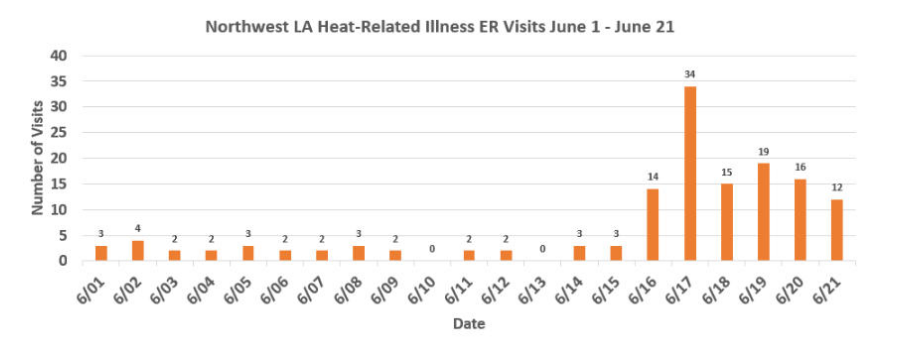Heatwave amidst power outage hospitalizes 110 in Northwest Louisiana
24 June 2023
The derecho of June 16th, affecting East Texas, Oklahoma, and Northwest Louisiana, knocked power out for over a quarter of a million SWEPCO customers during the longest and hottest days of the year. Heat advisories were issued by the National Weather Service in the aftermath of the storm, with the heat index reaching over 115 degrees Fahrenheit at peak on June 20th.
Two heat related deaths were confirmed by local media. Over the course of repairs, one lineman from West Virginia suffered from hyperthermia on the job in Marshall, Texas, and was later declared dead at the hospital. In Keithville, Louisiana, an elderly woman was found dead by her family following exposure to high heat. According to data provided to Scalawag by the Louisiana Department of Health, 110 people were hospitalized for hyperthermia in Northwest Louisiana alone over June 16th to the 21st, with 34 of those hospitalizations occurring on June 17th.

Severe weather has become more frequent in North Louisiana, with the region also being beset by the eastward shift of tornado alley. One explanation offered for this increasing frequency of severe weather is the change in climate caused by human greenhouse gas emissions. Greenhouse gasses trap heat in the atmosphere, causing an increase in average temperature as they accumulate in the atmosphere. These higher average temperatures promote the more frequent formation of tornadoes, and have increased the length of tornado season. Derechos, or straight-line storms, such as the one that struck on June 16th, are also likely to become more frequent with the changing climate.
According to the 2021 Annual Electric Power Industry Report, SWEPCO customers faced an average of 35 hours of the year without power, above the national average of just over 8 hours.
As average temperatures increase, and as severe storms increasingly threaten power infrastructure, provisioning electricity continuously and reliably will require weatherization investments by utilities to enable power infrastructure to withstand extreme winds. Scalawag reached out to Foster Campbell of the Louisiana Public Service Commission to ask if the commission has any plans to encourage such investments in the power system’s resilience by Louisiana’s utility monopolies, but we received no response.
Some local efforts have been announced prior to the storm to improve our region’s resilience to severe weather. The Caddo Commission has worked with North Louisiana Interfaith and the Community Lighthouse Project, providing $500,000 to construct solar power installations for Shreveport’s Highland Center and Morning Star Baptist Church to power heating/cooling centers in the aftermath of power outages and fuel shortages. Fuel shortages did occur in the aftermath of the storm. Long queues were formed around gas stations, many of which ran out of fuel, as people lined up to buy gas to power portable generators.
The storm and ensuing power outage have demonstrated just how vulnerable the electric grid is to climate-related disruption. The wave of hospitalizations for hyperthermia in Northwest Louisiana demonstrate how such disruptions threaten public health. It remains to be seen if government action will follow in preparation for future storms.